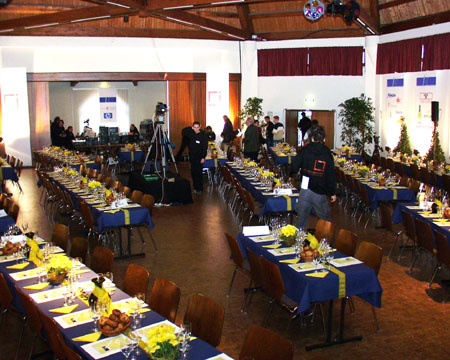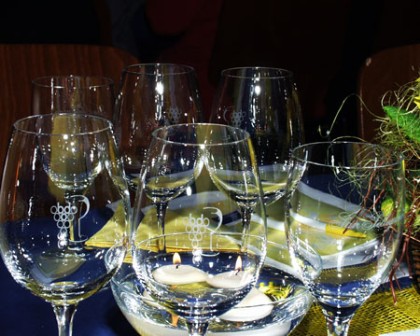
The fact that Riesling is no longer exclusively "the royal grape of the Rhine and its tributaries", as the legendary Emile Peynaud put it, is no longer a secret, at the latest since the international success of Austrian top Rieslings. But even with these wines, some self-appointed guardians of the "real Riesling" start to complain: "too strong", "too concentrated", "not typical for Riesling", they say. What would these people say if they were to taste Rieslings from other continents?
This was the question that was on my mind when I left Hattenheim that morning to go to the cathedral center in Geisenheim, the venue of the first worldwide Riesling event. For the first time, typical representatives from some of the most important wine growing regions of the world were to be presented to a large audience of winemakers, wine experts, enologists, journalists and wine lovers. And not to find out which of them is the best, but to show the many styles and philosophies that can characterize the (in this case dry) Riesling. The event, which was initiated by the Association of German Oenologists, the Wiesbaden University of Applied Sciences, the Geisenheim Research Institute, and the Association of Former Geisenheimers, was completely based on the internet as a central medium, be it for the live transmission to wine lovers all over the world, the global discussion round via chat, or the direct connection to the producers of the wines in question in South Africa, California, or Australia.
The order of the tastings was determined by the live connections to the individual producers overseas. Between the wines from other continents, several Rieslings of European provenance were always served while the respective connection was being tinkered with. The beginning was made by two Australian Rieslings from Stephen and Prue Henschke, who both enjoyed two years of training in Geisenheim in the 1970s. Although they are mainly known for their Shiraz "Hill of Grace", which even the most serious collectors would have pin-up figures tattooed on their forearms without hesitation in order to get hold of it, the couple is also passionately committed to the cultivation of Riesling in Australia. Both wines captivate with crystal-clear Riesling fruit, mineral notes and piquant acidity, which is not of natural origin, as Stephen Henschke confirmed upon request, but nevertheless did not seem artificial at all. However, both wines lacked some fruit depth and length.
The first Riesling from Germany could also be said to have something like an exotic status. Martin Tesch has been practicing biological acid reduction on his 20-hectare estate for years, but this is hardly ever noticeable in the wines. Thus, the dry late vintage from the Laubenheimer Karthäuser is a beautiful Nahe Riesling with fine fruit, playful acidity and a firm, mineral structure.
Catherina, a semi-dry Riesling cuvee from Grans-Fassian, Leiwen, Mosel, is also intensely mineral. However, the minerality here has a somewhat rustic touch, which makes the wine appear rather tart despite some residual sweetness. Gerhard Grans produces some of the finest residual and noble sweet wines in Germany, but the dry and almost dry wines sometimes lack a little bit of juiciness and substance to compensate the terroir spiciness, which is very emphasized here.
The two Wachau Smaragd wines from Franz Prager cannot be accused of lacking substance. But here, too, in addition to dense, juicy fruit, great importance is attached to a pronounced minerality. While the Ried Klaus focuses on substance and power, the Steinriegel seems a bit more elegant and racy. However, both Rieslings are not in ideal condition at the moment and will only be able to show their full potential in a few years. Nevertheless, even in this condition, they were among the highlights of the afternoon.
Another Geisenheim graduate is Dany De Wet from the De Wetshof wine estate, Robertson, South Africa. So it's no wonder that De Wet, contrary to the general trend towards increased red wine cultivation, is ironclad in his specialization for white wines. In Europe, however, De Wetshof is much better known for its Chardonnays and Sauvignon Blancs. Wrongly, as the 2000 Rhine Riesling proves with fine-juicy fruit, good substance and an interesting play of aromas.
Unfortunately, Alsace as a classic Riesling growing region was not ideally represented with the Grand Cru Florimont from Kuehn in Ammerschwihr. Lactic aromas in the nose and a relatively meager appearance on the palate left little joy.
However, this was already restored with the next wine, a picture book cabinet from Schloss Vollrads. After this traditional estate had been working below its potential for years, a first-class quality level combined with a clear change of style was achieved in a very short time under the new director Rowald Hepp. The Kabinett with its crystal-clear fine juicy fruit, the playful acidity and the fine minerality in the background is exemplary for this.
The last German participant of the tasting comes from a legendary vineyard. The Forster Kirchenstück was classified in 1830 by the royal tax cadastral commission in the highest of 65 classes and is still considered one of the best Riesling sites ever. The 99er Spätlese trocken from the Eugen Müller winery takes this into account with clear, juicy peach fruit, full body, sustained minerality on the palate and perfect balance.
Randall Grahm, the ingenious joker from the Bonny Doon wine estate in Santa Cruz, California, would probably have grinned like a lottery millionaire if he had been able to observe the reactions of the assembled vintners at our table to his two Rieslings. Everything was there, from angry fervour to leaning back contentedly in the awareness of apparent superiority. They all agreed: THAT had nothing to do with Riesling, was "international", "made" and in general indiscussable. The composition of the '99 Pacific Rim must seem like heresy to some purists: Besides grapes from vineyards in California and Washington, also those from Nahe and Mosel were processed. The result is a zesty Riesling with distinctly vegetal and floral aromas, citrus fruit and good structure. The '98 Critique of Pure Riesling is of a completely different caliber, an immensely juicy, full-bodied wine with distinct but perfectly integrated wood spice, a complex spectrum of flavors, and great presence and length. A wonderful sacrilege and at the same time the most fascinating wine of the day.

In conclusion, the entire event can only be described as a success, despite a few teething problems. The supporting program was also successful. After the communication designer and photo artist Norbert Bretschneider introduced the twelve wines to an astonished audience under the motto "Weinsinnig - Weinaromen visuell" (Wine sensual - wine aromas visually) in new dimensions for eye, ear, nose and tongue, an 8-course menu, to which the described wines and some other wines of former Geisenheim students were served, prolonged the evening until after 1 o'clock. The moderators of the program were a stroke of luck. While in the afternoon Prof. Dr. H. R. Schulz led through the tasting in a good mood, wine auctioneer Prof. Dr. Leo Gros, who in another life would have surely become world famous due to his humor and his imperturbability as a presenter of "Risk your Life" - TV plays, amused the guests with always new anecdotes not only about each wine, but also about each course served.
I'm already looking forward to the next time.